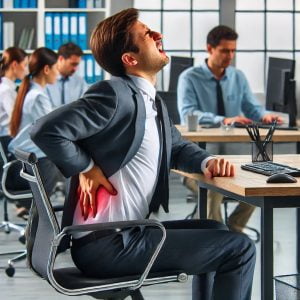
How the Right Office Chair Can Help Your Back Pain
80% of office workers report having back pain at some point in their careers. Causes of upper and lower back pain are often attributed to poor workplace ergonomics.
Height adjustable desks, both manual and electric, are available throughout South Africa, but what are the ergonomics of standing desks? Should you alternate between sitting and standing at work? It is well known that remaining in one position, whether sitting or standing for long periods at a time will have negative effects on your overall health. 10 Things That Happen When You Sit Down All Day.
Changing from sitting to standing will not necessarily combat the negative effects of sitting statically all day. In the same way, standing all day at work is also unhealthy. Everyone knows sitting all day at the office is bad for you, but standing might not be much better - Business Insider, Australia.
Due to the disadvantages of prolonged sitting and standing, adding simple office stretches and exercises to your day can reduce stress, increase energy, and improve your overall mood and creativity. To reduce the health risks of sitting, it is important to keep your body and mind healthy by taking time to move and exercise. This becomes even more important for anyone working remotely as health and ergonomics often take a "back seat". Remote Work – Pros and Cons.
World Health Organisation - How much physical activity should you be doing?

"I am a trained Office Ergonomic Risk Facilitator at Karo and understand the importance of ergonomics in the workplace. I have done extensive online research on sitting versus standing at work and was quite surprised by the varied perspectives from bloggers and ergonomics experts, especially as far as the use of a standing desk is concerned. Some maintain that standing at work is the “NEW BEST THING”, while for others it is a big “NO-NO”. These varied perspectives prompted me to share my own personal experience.
In June 2020, I suffered from a pinched nerve in my lower back, causing me intense agony for a period of three months. The excruciating pain radiated from my lower vertebrae and spread into my hips, back, buttocks, and legs. It reached a point where I couldn't endure sitting still for more than 30 minutes without needing to shift. Luckily, during this challenging time, I was testing a HiLo electric height-adjustable standing desk at my workplace. The desk's programable memory function became my lifeline, enabling me to effortlessly switch between sitting and standing positions with a simple touch of a button.
To alleviate my pain, I started incorporating more standing into my work routine and increased my overall daily movement. Without a fixed pattern, I constantly alternated between sitting and standing and took short walks whenever I felt any discomfort in my body.
Although I had received advice to perform specific exercises to stabilise my spine, the severe pain and discomfort made it impossible for me to follow through with them. Recognising the importance of movement in the healing process, I began taking walks to visit colleagues in another building and then returned to my office. This daily routine of alternating between sitting, standing, and walking significantly reduced my pain levels and facilitated my full recovery. To this day, I continue to follow the same daily regimen, and I have also incorporated a set of straightforward exercises for office workers to enhance my overall wellbeing."
For the greatest overall benefit, I believe that a balanced approach is needed where you combine sitting, standing and movement at work.

There are 2 basic options when it comes to manual height adjustable desks. The first uses a simple crank, and the second, a pneumatic lifter to raise and lower the desk.
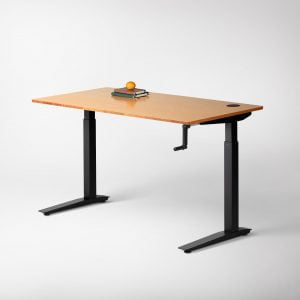
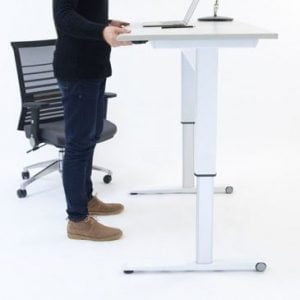
These ergonomic height adjustable standing desks are freely available in South Africa. The electronic control system enables you to change the desk height within seconds at the simple touch of a button.
Standing desks are versatile and beneficial in a range of work environments, including as executive and office desks. For executives, they promote better decision-making and productivity by keeping you alert and energised. They also reduce the strain of sitting for long hours, allowing for more movement between tasks. Plus, their sleek, modern design adds a professional touch to any executive office. In standard office setups, standing desks help improve posture, boost focus, and make collaboration easier by allowing for quick stand-up meetings. They also offer flexibility, letting employees switch between sitting and standing throughout the day for comfort.
At home, standing desks are space-efficient and perfect for remote workers wanting to stay active. They create a dynamic workspace, letting you move between tasks without the fatigue of sitting all day. For creative professionals, standing desks encourage movement and idea flow, fitting seamlessly into collaborative spaces. In reception areas, they allow for a more dynamic greeting experience, while in health-conscious workplaces, they help promote movement and reduce sedentary habits. Even in call centres, standing desks boost energy and efficiency, making them a smart choice for a wide range of work settings.
A height-adjustable desk is essential for setting up an ergonomic workstation because it allows you to adjust your chair and desk independently, customising each to suit your body’s specific needs. Your chair should be adjusted first, ensuring that your feet are flat on the floor, your knees are at a 90-degree angle, and your back is well-supported. This setup helps reduce strain on your legs and lower back, providing a solid foundation for good posture.
Once your chair is correctly positioned, the height of your desk should be adjusted to complement it. The desk should allow your arms to rest comfortably at a 90-degree angle when typing or using a mouse, preventing unnecessary strain on your shoulders, arms, and wrists. This alignment ensures you maintain a neutral posture throughout the day, minimising the risk of repetitive strain injuries.
By adjusting your chair and desk separately, you can create a workspace that perfectly fits your body’s unique needs, promoting long-term comfort and productivity. A height-adjustable desk offers the flexibility to make these vital adjustments and to alternate between sitting and standing, further enhancing the ergonomic benefits.
Based on my personal experience, to improve your overall physical and mental wellbeing, change your working position often (sitting to standing and back again), and include frequent movement in your daily work routine.
Invest in an ergonomic height adjustable standing desk but do your homework as there are many types available in South Africa. In my opinion, an electric height adjustable desk is definitely the answer! These desks enable you to quickly, easily and frequently change from a sitting to a standing position during your working day. This, together with regular movement, will ensure you to achieve the greatest benefit to your health and wellbeing.
Because of the effort involved in adjusting a manual standing desk, it is unlikely that you will adjust it as often, and so the overall ergonomic benefit will be less. This is particularly the case with crank handle height adjustable desks.

Important:
Seek the advice of your health professional if you have any medical condition that may not be conducive to standing or exercises.

80% of office workers report having back pain at some point in their careers. Causes of upper and lower back pain are often attributed to poor workplace ergonomics.
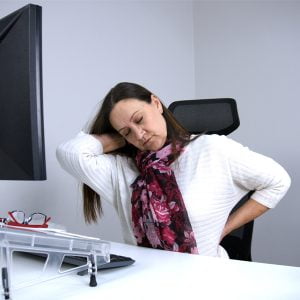
A case study of how I conquered debilitating back pain at work.
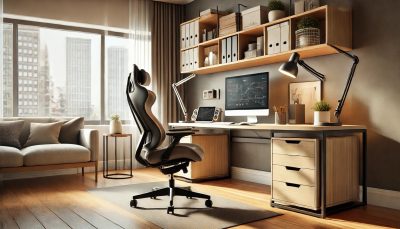
Whether you work from home part-time or full-time, a good setup is essential!


